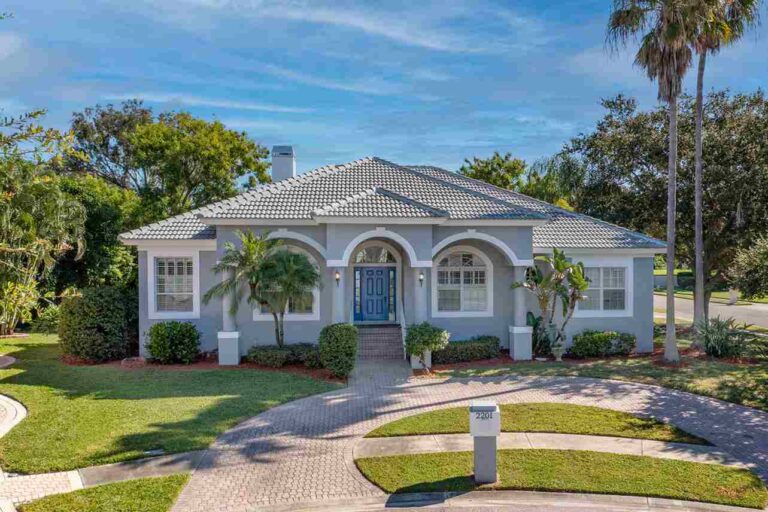Thinking about jumping into the St. Petersburg real estate market? You’re not alone.
This sunny Florida city has caught the eye of home buyers, investors, and folks looking to change their lifestyle.
But before you make any moves, let’s walk through what’s really happening in St. Pete right now.
The St. Petersburg housing market in 2025 looks nothing like it did a few years ago.
With beaches, culture, and year-round sunshine, St. Pete has transformed from a sleepy retirement town into one of Florida’s hottest real estate spots.
Whether you’re looking to buy your first home, upgrade to waterfront living, or invest in rental property, knowing the ins and outs of this market will save you headaches and potentially thousands of dollars.
Let’s break down the 10 most important things you need to know before making your move.
10 Things To Know About St. Petersburg Real Estate Market
St. Petersburg’s real estate market in 2025 combines strong demand with changing dynamics.
While companies like “We Buy Houses St Petersburg FL” stay busy with investment properties, everyday buyers face a market that’s both opportunity-rich and challenging.
From downtown condos to historic neighborhoods and waterfront estates, St. Pete offers something for nearly every budget and lifestyle preference—though competition remains fierce for the most desirable properties.
Strong Demand in a Competitive Market
The interest in St. Petersburg real estate hasn’t slowed down—just shifted gears.
What we’re seeing is a market that stays hot but moves at a more normal pace than the frenzy of recent years.
Houses in popular neighborhoods like Old Northeast and Kenwood still get multiple offers, often within days of listing.
The difference now? Buyers are more careful, taking time to inspect properties and negotiate terms rather than rushing in with no-contingency offers.
For sellers, this means smart pricing matters more than ever.
Gone are the days when you could list at any price and expect a bidding war.
Today’s buyers know the market and won’t overpay.
The sweet spot? Homes priced between $400,000-$600,000 move fastest, while luxury properties over $1 million stay on the market longer unless they’re priced right from day one.
Diverse Neighborhoods With Unique Appeal
St. Petersburg isn’t just one market—it’s dozens of mini-markets, each with its own vibe and price point.
Historic Kenwood attracts buyers who love Craftsman bungalows and a strong sense of community.
Old Northeast offers tree-lined streets with character homes close to downtown.
Pinellas Point gives you more space for your money with larger lots and water views in many areas.
For younger buyers and singles, the EDGE District and Grand Central offer walkability and nightlife.
Families often look to Causeway Isles and Snell Isle for top schools and larger homes.
The price differences between neighborhoods can be huge.
The same 3-bedroom house might cost $450,000 in Disston Heights but $950,000 in Snell Isle—just a few miles apart.
Smart buyers choose neighborhoods based on lifestyle needs first, then find the right house.
The wrong neighborhood with the perfect house still means the wrong house for you.
Price Trends and Median Home Values
Let’s talk numbers. The median home price in St. Petersburg hit $425,000 in early 2025—up 4% from last year but showing signs of stabilizing.
What’s interesting is how unevenly prices have grown.
Luxury waterfront properties saw only 2% growth, while starter homes under $350,000 jumped nearly 8% due to fierce competition among first-time buyers.
Condos and townhomes now average $380,000 citywide, with downtown units commanding premium prices around $500,000 for updated spaces.
The days of 15-20% annual price growth are gone.
Most experts predict 3-5% growth for the next few years—more normal and healthy for the long term.
For buyers worried about buying at the peak, remember that St. Pete remains more affordable than Miami, Tampa, and many other Florida coastal cities.
Your dollar still stretches further here, though that gap narrows every year.
Impact of Remote Work and Lifestyle Migration
Remote work changed everything for St. Petersburg real estate.
The ability to work from anywhere sent thousands of new buyers to Florida, with St. Pete as a top choice.
People who once visited as tourists now live here full-time, bringing higher incomes and different expectations to the housing market.
They want homes with dedicated office space, outdoor space areas, and good internet—not just vacation vibes.
The average new St. Pete resident in 2025 earns 30% more than existing residents, creating both opportunities and tensions in the housing market.
They can afford higher prices, which helps sellers but makes things tougher for local buyers.
Neighborhoods like Crescent Lake and Euclid/St. Paul have transformed as remote workers seek homes with character near parks and coffee shops.
These buyers often don’t mind renovation projects if the location works for their lifestyle.
The remote work trend shows no signs of slowing—expect continued demand from out-of-state buyers through 2025 and beyond.
Booming Condo and Waterfront Property Market
Waterfront living defines St. Petersburg, and despite higher insurance costs, waterfront properties remain hot tickets.
Beach condos on St. Pete Beach and Treasure Island sell quickly, while waterfront single-family homes often move through private sales before hitting the open market.
The downtown condo market has exploded with new buildings like The Nolen and The Stella setting price records above $800 per square foot.
Older condo buildings offer better value but often come with special assessments for updates and repairs.
Flood insurance remains the biggest challenge for waterfront buyers, with annual premiums sometimes reaching $10,000+ for single-family homes in high-risk zones.
Smart buyers factor these costs into their budgets from day one.
For those priced out of direct waterfront, “near water” neighborhoods like Tropical Shores and Coquina Key offer water access and views at somewhat lower price points.
The best waterfront values? Look at areas slightly outside city limits like Seminole and South Pasadena, where similar properties can cost 15-20% less than in St. Pete proper.
Investment Opportunities and Short-Term Rentals
St. Petersburg has become an investor’s playground, especially for those focused on short-term rentals.
With tourism booming year-round, vacation rentals often generate twice the income of traditional long-term rentals.
The highest returns come from properties near downtown and the beaches.
A well-located two-bedroom condo can generate $30,000-$40,000 annually in vacation rental income if managed correctly.
New city regulations have tightened rules around short-term rentals, making it crucial to check zoning and HOA restrictions before purchasing.
Many condo associations have banned rentals under 30 days, limiting options for vacation rental investors.
For traditional long-term rental investors, neighborhoods like Bartlett Park and Childs Park offer better cash flow potential with entry prices still under $300,000 for single-family homes that can rent for $1,800-$2,200 monthly.
The best investment strategy combines appreciation potential with decent cash flow—something increasingly hard to find as prices rise.
Multi-unit properties remain gold mines when you can find them, but they rarely hit the open market.
New Construction and Development Projects
Cranes dot the St. Petersburg skyline as developers race to meet housing statistics demand.
New condo towers like The Ascent and Marina Club have transformed the downtown waterfront, while smaller infill projects bring modern townhomes to historically affordable neighborhoods.
The most significant development? The 86-acre Tropicana Field redevelopment promises thousands of new housing units, office space, and retail over the next decade, potentially shifting the center of gravity away from the current downtown core.
New construction homes start around $600,000 for modest sizes, with most new single-family homes priced well above $800,000.
This premium reflects both higher building costs and the scarcity of buildable lots within city limits.
Townhome communities offer the most affordable new construction, with prices starting in the high $400,000s for two-bedroom units.
These appeal to both young professionals and downsizing empty-nesters looking for low-maintenance living.
The downside of all this development? Traffic congestion has worsened considerably, and some longtime residents worry about losing St. Pete’s character to generic luxury property sale.
Cost of Living and Property Taxes
Beyond purchase price, St. Petersburg’s cost of living surprises many newcomers.
While Florida has no state income tax, other costs can add up quickly.
Property taxes run about 1.5% of assessed value annually, with a homestead exemption available for primary residents that can save thousands.
However, non-homesteaded properties face much higher tax bills—something investors must factor into their calculations.
Insurance costs have skyrocketed, with typical homeowners paying $3,000-$5,000 annually for standard coverage—more for flood and hurricane protection.
Some older homes need expensive updates to qualify for insurance at all.
Utility costs run higher than national averages due to year-round air conditioning needs.
Water bills particularly shock newcomers, averaging $100+ monthly for typical households.
The good news? Everyday expenses like groceries and restaurant meals remain reasonable compared to major northern cities, and transportation costs drop for those who can walk or bike in St. Pete’s compact layout.
Market Challenges and Risks
No market is perfect, and St. Petersburg faces real challenges.
Climate change tops the list, with sea level rise threatening low-lying areas and hurricane risk growing yearly. Insurance companies have noticed—some have left Florida entirely, while others charge premium rates that climb annually.
The market also faces affordability challenges as local wages fail to keep pace with housing costs.
This creates dependency on wealthy out-of-state buyers and investors, potentially making the market vulnerable to national economic shifts.
Interest rate fluctuations hit St. Pete harder than some markets because so many purchases involve financing.
Even small rate increases price out significant numbers of potential buyers.
Construction quality concerns plague some boom-era developments, with buildings from 2004-2007 particularly problematic.
Smart buyers budget for unexpected repairs, especially in properties built during high-growth periods.
Despite these challenges, St. Petersburg’s fundamentals remain strong—limited land, growing population, and persistent demand suggest the market will weather future storms, both literal and economic.
Tips for Buyers and Sellers in 2025
For buyers: Get pre-approved before shopping and know your true budget including insurance and taxes.
Work with agents who know specific neighborhoods—generalists often miss crucial details about flood zones, school boundaries, and property values.
The best deals hide in plain sight—properties with dated kitchens and bathrooms but solid structures often sell for 15-20% less than updated homes.
A $50,000 property renovation can create $100,000+ in instant equity.
For sellers: The days of minimal prep and maximum price are over.
Today’s successful sellers invest in pre-listing inspections, strategic updates, and professional staging.
Homes that show like model houses still command premium prices and sell faster.
Pricing strategy matters more than ever—the first two weeks on market are critical.
Overpriced listings stigmatize properties and ultimately lead to lower final prices.
Both buyers and sellers benefit from flexibility on closing timelines.
The ability to accommodate the other party’s moving needs often makes the difference in competitive situations.
Conclusion
The St. Petersburg real estate market in 2025 offers opportunities for those who approach it with knowledge and realistic expectations.
While no longer the bargain it once was, St. Pete continues to attract buyers with its unique blend of natural beauty, cultural amenities, and Florida lifestyle.
Whether you’re buying, selling, or investing, success comes from understanding both the big-picture trends and neighborhood-specific dynamics.
The right move at the right time can still pay dividends in this evolving but fundamentally strong market.



